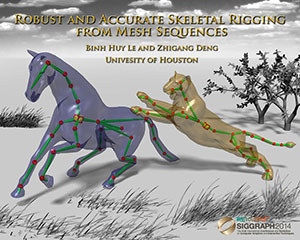UH Computer Graphics Research: New Method Automates Skeletal Design for Character
Animation
Research to be Presented at ACM SIGGRAPH 2014 Conference

Highly accurate skeletons can be automatically extracted from example poses using
Le and Deng’s new method. Generating realistic 3D character animation is a core element of designing computer-generated
movies, video games, virtual reality, and virtual world applications. Currently, many
steps in the character animation pipeline rely on the manual efforts of skilled artists.
For this reason, generating high-quality, plausible animations is costly.
Computer graphics researchers at UH have developed a new technique to automate the process.
Conventional Character Rigging
Human and animal characters present a challenge in animation because real-life movement is fluid, involving the joints, skeletal structure and outer skin. To animate realistic 3D human or animal characters, artists often simulate the anatomical structure by embedding a skeleton into a 3D static shape of the character and set up a model to generate how the exterior skin moves with different skeletal configurations.
This process, called rigging, typically involves manually drawing a skeletal structure and painting a color-coded map on the character’s surface to control how the bone articulations blend and generate surface movement. In practice, artists repeat many such trial-and-error steps to refine the character deformation with good results.
Automatic Rigging from Examples
The UH researchers, however, tackled the problem from a different perspective, developing a method to automatically extract the skeletal rigging model from a collection of shapes, called example poses.
“If you observe the shape of the character in many different poses, you can eventually learn its intrinsic deformation behavior. Moreover, you can learn more about the internal skeletal structure,” said Binh Le, the first author of this work, who recently completed his Ph.D. in computer science at UH. “This learning problem can be formulated as a mathematical optimization problem, where we try to find the best set of parameters to generate shapes that closely match the example poses.”
The UH team reconstructed example poses using performance capture or dense-motion capture based on a multiple-camera system.
“Since the skeletal rigging model extracted from example poses is typically compatible with game engines and popular animation, software such as Autodesk Maya, it can be easily used for various animation editing, compression and rendering applications. The method helps reduce production costs,” said Zhigang Deng, second author of the work and a UH associate professor of computer science.
Le and Deng will present this research finding at the Association of Computing Machinery’s SIGGRAPH 2014 conference on August 12 in Vancouver, Canada. ACM SIGGRAPH is the most prestigious annual conference in computer graphics and is attended by tens of thousands of computer professionals from around the world. It is the largest academic conference in computing technology sponsored by ACM.
Deng added that their method could be a potential solution to extracting the anatomical skeleton of living creatures from their exterior shapes.
“Computer graphics techniques, like our algorithm, could have potential impacts and applications for computational biomedicine and biomedical informatics. For example, it would be interesting to investigate the quantitative difference between the skeleton extracted by our automated algorithm and the actual anatomical skeleton of a human or animal,” Deng said.